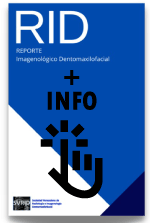Magnetic resonance as a complementary method in the diagnosis of sublingual salivary gland pathologies
DOI:
https://doi.org/10.60094/RID.20230202-30Keywords:
Magnetic resonance imaging, sublingual salivary glands, neoplasiaAbstract
Multiple factors can cause pain and inflammation of the salivary glands related to infectious processes, generally of bacterial origin, they can also be of viral origin, tumor alterations, sialoliths, among others, these pathologies being more common among elderly patients Sialadenitis is the most common pathology, affecting the submandibular glands in 70% and sialolithiasis in 1% in the sublingual salivary glands, where we can find changes in the composition of the saliva, consistency and even morphophysiological alterations of its different structures. These characteristics manifest themselves in different pathologies of the salivary glands, including: sialadenosis, pleomorphic adenoma, sialolithiasis, among other reasons why the clinical correlation with the imaging study is crucial for the correct diagnosis of our patients and therefore obtaining the best treatment for them. The case of a patient with a pathological process in the sublingual gland is presented. The information obtained through Magnetic Resonance allowed better planning, approach and performance of the excisional biopsy without complications.
Downloads
References
Ruiz E, Barrios A, Díaz F. Patología de las glándulas salivales En: SEORL PCF,editor. Libro virtual de formación en ORL. Cartagena; 2017. p. 60-9.
Vergez S, Isquierdo J, Vairel B. Patología médica de las glándulas salivales. En: EMC – Otorrinolaringología. 2023;53(1):1-20. DOI: https://doi.org/10.1016/S1632-3475(22)47321-8
Resende EA, Gomes NR, Abreu LG, Castro MAA, Aguiar MCF. The applicability of ultrasound in the diagnosis of inflammatory and obstructive diseases of the major salivary glands: a scoping review. Dentomaxillofac Radiol. 2022;51(4):20210361. DOI: https://doi.org/10.1259/dmfr.20210361
Syebele K, Munzhelele TI. The anatomical basis and rational for the transoral approach during the surgical excision of the sublingual salivary gland for the management of plunging ranula. Am J Otolaryngol. 2020;41(2):102371. DOI: https://doi.org/10.1016/j.amjoto.2019.102371
Reig-Montaner E, Antón-Almero M, Ferrer-Ramírez M. Análisis clínico yterapéutico a la patología obstructiva crónica de las glándulas salivales. Acta Otorrinolaringólogo Cir Cabeza Cuello. 2021;49 (4):279-284.
Sobrino-Guijarro B, Cascarini L, Lingam RK. Advances in imaging of obstructed salivary glands can improve diagnostic outcomes. Oral Maxillofac Surg. 2013;17(1):11-9. DOI: https://doi.org/10.1007/s10006-012-0327-8
Santos Armentia E, Martín Noguerol T, Suárez Vega V. Advanced magnetic resonance imaging techniques for tumors of the head and neck. Técnicas avanzadas de resonancia magnética en patología tumoral de cabeza y cuello. Radiologia (Engl Ed). 2019;61(3):191-203. DOI: https://doi.org/10.1016/j.rx.2018.12.004
Rozas M, Fiori G, Llaguno J. Revisión narrativa de estudios por imágenes de las calcificaciones de las glándulas submandibulares. Rev Cient Odontol [Internet]. 2023;11(1):e143.
Park KW, Han AY, Kim CM, Tam K, Chhetri DK. Contrast-Induced Sialadenitis of the Sublingual Glands. Case Rep Otolaryngol. vol. 2020 885138 DOI: https://doi.org/10.1155/2020/8851382
Jiao A, Farsad K, McVinnie DW, Jahangiri Y, Morrison JJ. Characterization of Iodide-induced Sialadenitis: Meta-analysis of the Published Case Reports in the Medical Literature. Acad Radiol. 020;27(3):428-435. DOI: https://doi.org/10.1016/j.acra.2019.05.006.
Gamaleldin O, Magdy EA, Zoheir H, Shehata GM, Elsebaie N. The role of magnetic resonance imaging and magnetic resonance sialography in the evaluation of salivary sialolithiasis: radiologic-endoscopic correlation. Pol J Radiol. 2022;87:e430-e437. Published 2022 Aug 5. DOI: https://doi.org/10.5114/pjr.2022.118899
Abe A, Kurita K, Hayashi H, Minagawa M. A case of minor salivary gland sialolithiasis of the upper lip. Oral Maxillofac Surg. 2019;23(1):91-94. DOI: https://doi.org/10.1007/s10006-019-00745-6
Badash I, Raskin J, Pei M, Soldatova L, Rassekh C. Contemporary Review of Submandibular Gland Sialolithiasis and Surgical Management Options. Cureus. 2022;14(8):e28147. DOI: https://doi.org/10.7759/cureus.28147
Hernández MC, Martín M, Marín J, Hernández R, García I, Tabernero R. Resonancia magnética de las glándulas salivales parótida y submaxilar. Rev ORL [Internet]. 2017;8(4):227–36.
Pousya V, Shetty U, Shetty P. Sialolith with sialadenitis: A case study and aproposal of a diagnostic algorithm. J Health Allied Sciences NU [Internet]. 2023. Disponible en: http://dx.doi.org/10.1055/s-0043-1768590
Published
How to Cite
Issue
Section
License
Copyright (c) 2023 Ana González, Gabriela Sánchez , Carlos Manresa, José Andrés Güitian, Adalsa Hernández-Andara

This work is licensed under a Creative Commons Attribution 4.0 International License.
This work is licensed under a Creative Commons Attribution 4.0 International License.
AUTHORS RETAIN THEIR RIGHTS:
You are free to:
- Share: copy and redistribute the material in any medium or format for any purpose, including commercially.
Adapt: remix, transform and build upon the material for any purpose, including commercially.
The licensor cannot revoke these freedoms as long as you follow the terms of the license under the following terms:
- Attribution : you must give proper credit , provide a link to the license, and indicate if changes have been made. You may do so in any reasonable manner, but not in such a way as to suggest that you or your use is supported by the licensor.
- No additional restrictions: you may not apply legal terms or technological measures that legally restrict others from making any use permitted by the license.











